Alcohols - Alcohol Reactivity (A-Level Chemistry)
Alcohol Reactivity
Elimination
When alcohols are heated with an acid catalyst, such as concentrated sulfuric or phosphoric acid, a water molecule gets eliminated forming an alkene.
The reaction mechanism for alcohol dehydration is as follow:

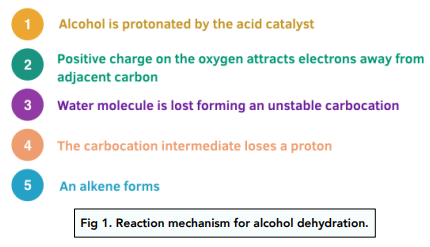
As shown in the diagram, the -OH group and an H get lost.
When alcohols are unsymmetrical different alkenes form depending on which H atom gets used to form the water molecule. There are often two possible alkene products, plus any of its cis-trans isomers.
Worked example: Concentrated sulfuric acid is heated with sample of butan-2-ol. A dehydration reaction takes place. Draw the structures of the resulting organic products.
Answer: The -OH group can bond with the H atom on either carbon 1 or carbon 3 to form the water molecule being eliminated.
If the H atom in carbon 3 gets involved, but-1-ene forms.
If the H atom in carbon 1 gets involved, but-2-ene forms. But-2-ene shows E/Z isomerism. Therefore both cis-but-2-ene and trans-but-2-ene form.
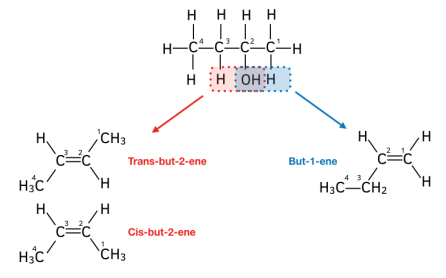
The alkene product is then distilled off.
Alcohol dehydration is a more sustainable way of making alkenes for polymerization than using crude oil.
Cyclohexene Formation
Clyclohexene can be produced from cyclohexanol by an elimination reaction. However, in order to get pure cyclohexane, a few more steps are required:
1. Distillation. Cyclohexanol is mixed with concentrated sulfuric and phosphoric acid and heated to 83ºC. The reaction vessel is connected to a condenser so that the products of the reaction can be distilled off.
2. Separation. The products of distillation are impure. In order to remove any impurities from the reaction products, these get added to a separating funnel with some water. Impurities dissolve in the water. Two layers form: an aqueous layer containing dissolved impurities at the bottom, and a layer of (still impure) cyclohexene at the top. Both layers are drained separately.
3. Purification. A drying agent such as calcium chloride gets added to the cyclohexene. To remove any remaining impurities, the mixture is distilled once more.
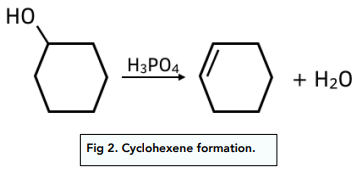
Nucleophilic Substitution
The partial positive charge on the hydroxyl carbon leaves it open to attack by nucleophiles.
Alcohols can therefore undergo nucleophilic substitution, like for example, when reacting with halogenating agents.
A halogenating agent is a compound that contains a halide ion. The halide ion is highly electronegative. It draws charge density from the adjacent carbon atom so that it has a partial negative charge which allows it to act as a nucleophile.
The -OH group gets replaced for the halide ion to form a halogenoalkane.
The reaction mechanism goes as followed:

Different halogenating agents require different reaction conditions and will give different side products.
The reaction mechanisms that you need to know about are:
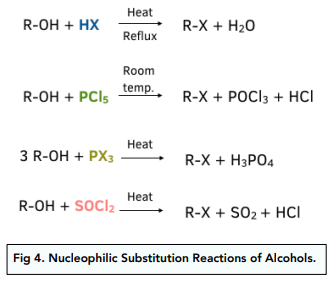
In all cases, the halogenating agent has to be concentrated and in excess, to shift the position of equilibrium to the right and drive the reaction to completion.
The commonest way to produce different halogenoalkanes from alcohols in a lab are:
- Chloroalkanes – By refluxing the alcohol with PCl5 or HCl.
- Bromoalkanes – By using KBr with an acid catalyst such as 50% concentrated sulfuric acid.
- Iodoalkanes – By heating the alcohol under reflux with red phosphorus and iodine to produce phosphorous triiodide, which then acts as the halogen carrier.
Esterification
Esterification is an example of a condensation reaction.
When alcohols are heated under reflux with a carboxylic acid, in the presence of an acid catalyst such as concentrated sulfur acid, an esterification reaction takes place to form an ester.
The -OH group in the carboxylic acid with the H atom in the alcohol hydroxyl group so that a water molecule is lost. A new bond forms between the carbonyl carbon in the carboxylic acid and the remaining O atom in the alcohol molecule. This is an ester link.
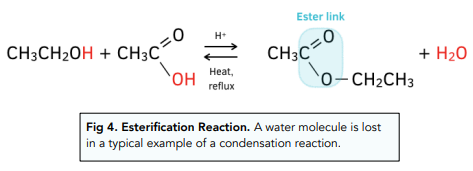
Reversing esterification
The reverse of esterification is hydrolysis.
The products of hydrolysis depend on whether it takes place in acidic or alkaline conditions:
- Acid hydrolysis – When an ester is heated under reflux with a strong acid such as hydrochloric acid, both the original carboxylic acid and the alcohol form. An equilibrium is set.
- Alkaline hydrolysis – When an ester is heated under reflux with a strong base such as sodium hydroxide, an alcohol and a carboxylate salt form. The reaction goes to completion.
Redox
Alcohols are reduced by sodium metal to form a sodium alkoxide and hydrogen.
Lets look at the reaction between ethanol and sodium as an example:
Ethanol + sodium → sodium ethoxide + hydrogen

Alkoxides are alcohol salts. They are very unstable and act as bases.
The reaction of alcohols with sodium is slower and less vigorous than the reaction between water and sodium. The longer the alcohol carbon chain, the less vigorous the reaction.





Still got a question? Leave a comment
Leave a comment